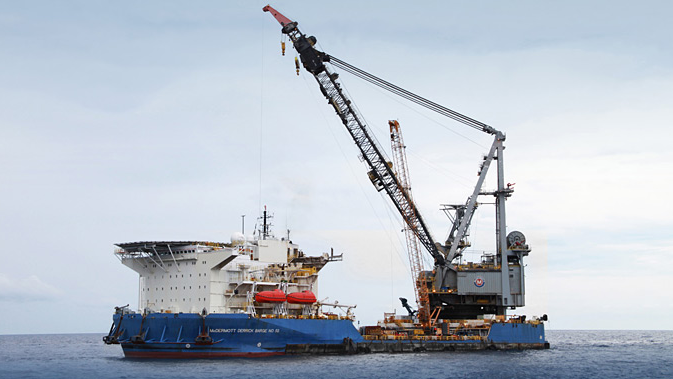Recent Posts
History of Heavy Lifts – in the Marine Context
Blog Post by: Captain Geoffrey English
September 23, 2019

McDermott’s Derrick Barge
Well, what is “heavy”? A hugely subjective adjective applied to anything from a stodgy meal to the topside of an offshore platform. So, what is a “heavy lift” in a marine context?
Back in the heyday of the five-hatch cargo ship, not so very long ago, and in the decades up to about 1970, many ships, in addition to their normal hatch derricks, also had a “big stick”. Typically, this was a single span derrick of substantial construction, invariably stowed upright when not in use, perhaps on the mast or samson post between hatches one and two and serving hatch two. Unless in use, it was likely to be un-rigged with the blocks and guys stowed below – rigging, with its associated “steam guys”, was a time-consuming business, likely to get the bosun and crowd cursing and ramp up the overtime bill! The end result being a rig perhaps able to handle a 50-tonne lift, usually for deck cargo.
The “big stick” evolved from the 1960’s into the Stulken Derrick, with its massive vee-shaped kingposts, permanently rigged, capable of serving two adjacent hatches and with a leap in capacity up to 300 tonnes, although 150-180 was much more common. These graced the fine-looking ships of Strick, BI, Ben Line, Harrisons and a host of other, now fading, names. The advent of container shipping coupled with reliable, high-capacity marine cranes has seen a polarisation of cargo carrying and the advent of a new generation of commercial heavy lift vessels, frequently able to manage a 1000 tonne lift with two cranes in tandem.
All of the above excludes the developments in offshore oil, gas and renewables construction. The former, gaining pace in the 1950’s and ‘60’s, especially in the Gulf of Mexico, brought us the derrick barge and ultimately the semi-submersible crane vessel (SSCV). Early players in this market were the US firm of McDermott and Heerema from Holland. The eponymous McDermott “derrick barge”, a misnomer as they were equipped with American Hoist or Clyde cranes, grew from simple anchor-moored pontoons to the dynamically-positioned monohull DB50 and latterly, in a joint venture with Heerema, into the SSCV DB102. Still one of the largest offshore heavy lift units, now operated by Heerema as the Thialf.
The migration of offshore oil and gas developments into deeper water and harsher environments, entailing bigger and heavier structures, spurred the advent of the SSCV, heralded in 1978 by the arrival of Heerema’s Balder and Hermod, with twin cranes and a potential lifting capacity of 7000 tonnes. In a largely booming oil market the demand for bigger and better continued in the mid 1980’s with the arrival of the Micoperi (latterly Saipem) 7000 and the acquisition of the Heeremac joint venture’s DB102 to become Heerema’s Thialf. Both of the latter are DP Class III equipped and capable of a 14,000 tonne tandem lift, with Saipem 7000 perhaps just having the edge in crane capability versus lift capacity.
What of tomorrow? We already have Allseas’ Pioneering Spirit in commission and removing entire platform topsides, with the intention to build something similar, but “bigger and better”. Also Heerema, having consigned the venerable Hermod to the scrapyard, are currently commissioning Sleipnir, with twin 10,000 tonne cranes. Will this be the pinnacle of heavy lift? Only time and an ever-shifting energy market will tell.





